Chronic Lung Disease: Helping with Treatment, For Caregivers
For someone with chronic lung disease, visits with the healthcare provider are key for good health. Encourage your loved one to take the lead in their care. Then offer support as needed. Work closely with the healthcare team. Make sure all appointments are kept. Also help make sure that treatment instructions are followed.
The healthcare team
Many providers can take part in treating chronic lung disease. Get to know these providers and what they do. This will help you feel better about asking questions.
-
Pulmonologist. Specialist focused on lung problems. May work with a primary healthcare provider to guide the treatment plan.
-
Respiratory therapist. Assesses breathing skills. Teaches breathing methods to ease symptoms.
-
Physical therapist. Teaches energy-saving methods. Oversees exercise and physical activity.
-
Nurse. Helps with all types of care. Can help answer questions. Puts treatment plans into action.
-
Social worker or case manager. Helps coordinate care. Answers questions about the healthcare system. Can also give referrals to needed services.
-
Pharmacist. Fills prescriptions. Also gives information about medicines and how to take them safely.
-
Nutritionist. Helps with the person's nutrition needs.
-
Representative from a home healthcare company. Helps with equipment needed for treatment, such as oxygen. Can set up equipment and show how it's used.
Visits to the healthcare provider
Go to provider visits with your loved one. To make the most of these visits, work together to:
-
Keep a file for health records. Include all medicines that are taken. Gather as much health history as you can. Bring the file with you to the provider’s visit.
-
Keep track of changes in symptoms, diet, and physical activity.
-
Make a list of questions and concerns. Make sure these are addressed before you leave the provider’s office.
-
Write down what the provider says. Bring a notepad or use an electronic device to do this.
Common treatments
 |
| Learn the names of your loved one's medications. |
Try to learn about your loved one’s treatment. This helps you support good care habits. Here are some common treatments:
-
Medicines. These help manage symptoms. Learn the names of any medicines given. Learn how they work and when they're taken. Some medicines need a special device. This may be an inhaler or nebulizer. Know how to use these devices. Go over the correct technique with the healthcare provider.
-
Oxygen therapy. This helps improve breathing. If oxygen is needed, follow all safety guidelines.
-
Pulmonary rehab (rehabilitation). This program trains people on exercise, emotional support, and managing symptoms. Team members often include healthcare providers, respiratory therapists, and physical therapists. Go to sessions with your loved one when you can.
-
Nutrition therapy. Diet changes can help manage chronic lung disease. Nutritionists often work on finding changes that may be helpful.
When to call the healthcare provider
Call the healthcare provider right away if your loved one has:
-
Slightly more shortness of breath, wheezing, or coughing
-
Mucus has increased, changed color, or is bloody
-
Tightness in the chest that won’t go away. This is similar to what's occurred before from chronic lung disease.
-
A fever of 100.4ºF (38ºC) or higher, or as directed by the provider
-
Chills
-
Feeling more tired and worn out (fatigue)
Call 911
Call 911 if any of these occur:
-
Severe shortness of breath
-
A large amount of blood in the mucus that's coughed up
-
Tightness or pain in the chest that's new or different, or that gets worse
© 2000-2025 The StayWell Company, LLC. All rights reserved. This information is not intended as a substitute for professional medical care. Always follow your healthcare professional's instructions.